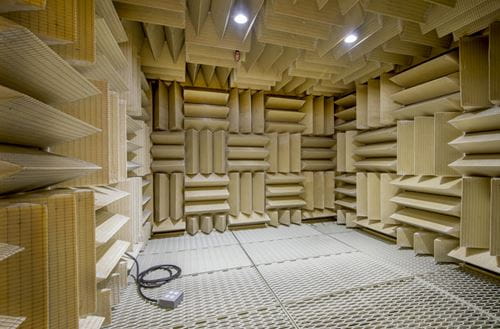
Semi-Anechoic and Reverberation Chamber use in Precision Motor Testing
When testing new motor products for any application, it is extremely important that prototypes are looked with a “fine tooth comb” before being put into production. All motors need testing to assure that they will perform as required, reliably. At Nidec Motor Corporation, as part of our leading-edge processes and testing methods, our state-of-the-art sound and vibration lab has a semi-anechoic chamber and reverberation chamber that are deployed as just two of the various tests performed routinely on our motors.
Both chambers are designed to isolate the product in question in an environment that is repeatable. This meaning that they both are designed to filter out external variables that would cloud proper calculations or measurements. Not only does this provide accuracy, but also speeds up the process of testing because engineers do not have to constantly adjust for background noise between tests. Both chambers, while having a similar goal, work in different ways.
Semi-Anechoic chambers are deafeningly quiet. With the name quite literally meaning “non-reflective, non-echoing, or echo-free", this chamber absorbs sounds and eliminates echoes to isolate the chamber from the outside environment. With motor testing, this isolation helps to gather precision sound from a source, the motor. The chamber construction is similar in design to the metal, double walled tumblers that we all drink from every day. This meaning that the chamber enclosure consists of two walls, separated by an air gap. Additionally, absorbing, soundproof material lines the inner walls, further insulating the chamber. For applications looking for sound or vibration, the sound source can be accurately measured from various directions.

Both chambers are invaluable tools for our engineers, and engineers globally. These environments allow a deeper look to best learn about new motor concepts, improve older motor concepts, and troubleshoot any issue that may arise throughout the lifespan of the motors. In situations where customers are finding repeating trouble, an engineer can use either one of these chambers to best replicate the environment where the motor was being used. From there, the issue can be located and consequently, the solution.
Pre-production testing is extremely useful to prevent any trouble to an end user, however testing throughout the creation process is an important second step for quality control. Recently, we introduced a virtual program for our motor testing at our Mena, Arkansas facility. This allows end-users a safe, convenient, and economical way to validate that production quality us up to specification and performance is at our top-notch quality. Read more about our virtual program or contact us for more information on how to enroll.

